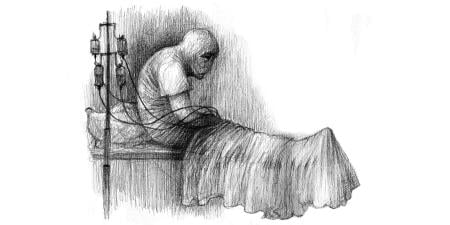Autonomy has been defined as “the quality or state of self-governing” [1]. In a health care context, respecting autonomy means allowing patients to make their own medical decisions. It also means allowing individuals to consent to participate in clinical research and to donate bodily tissues for research purposes. The boundaries of autonomy blur, however, once donated tissues leave the body, and the recipient researcher or university accepts the tissues.
The law has never established clear ownership rights in donated human tissues [2]. Historically, researchers and institutions have assumed that they retain the right to “collect, study, store, transfer, or dispose of tissue specimens and the associated patient data,” such as patented gene lines or means of genetic testing [2]. Though the Code of Medical Ethics of the American Medical Association prohibits the use of human tissue and its products for commercial purposes without the informed consent of the donor, physicians and researchers have assumed that they can use patient tissues and other bodily substances to develop cell lines, genetic sequences, and other biologic products that may be financially rewarding [3]. Patents have been granted or patent applications filed for an estimated 20 percent of human genes [4]. Several court cases have challenged researchers’ assumptions.
Moore v. Regents of the University of California
In the first case of its kind, the California Supreme Court held in Moore v. Regents of the University of California that individuals do not have an ownership interest in their cells after the cells are removed from their bodies. John Moore sought treatment from UCLA Medical Center (defendant) for hairy-cell leukemia. His attending physician, Dr. David Golde, recommended removal of Moore’s spleen for therapeutic purposes. Golde and UCLA researcher Shirley Quan planned to use Moore’s spleen tissue—which was “of great value in a number of commercial and scientific efforts”—for scientific study, a fact they never disclosed to Moore [5, 6].
Golde and Quan continued research on Moore for several years, causing him to incur inconvenience and expense associated with travel from Seattle to UCLA for visits that Golde misrepresented as medical appointments in the interest of Moore’s health, when, in fact, the purpose of the visit was to draw samples for more research [2, 5-7]. Golde ultimately succeeded in developing a cell line from Moore’s t-lymphocytes, and Golde, Quan, and the Regents of the University of California obtained a patent for the cell line then worth an estimated $3 billion [5, 6]. Golde also negotiated agreements for commercial development of the cell line and products to be derived from it.
Moore initiated a lawsuit against Golde, Quan, and the Regents, seeking to recover a share of the proceeds from the patented cell line. While the court recognized a physician’s duty to disclose personal interests—research or economic—when seeking informed consent for a medical procedure, it ultimately found that the resulting patented cell line was the product of invention, not of the donor [5-7]. Even if the excised cells initially belonged to an individual, those cells were legally and factually distinct from the resulting research product [2, 5, 6]. Thus, the court held that individuals donot have an ownership interest in their cells after the cells are removed from their bodies [2, 5, 6].
The Moore decision remained the authority on a researcher’s right to donated human tissue until 2003, when the issue arose once again.
Greenberg v. Miami Children’s Hospital Research Institute, Inc.
In Greenberg v. Miami Children’s Hospital Research Institute, Inc., the U.S. District Court for the Southern District of Florida held that individuals have no property rights in body tissue and genetic material donated for research. The Greenberg family sued a physician-researcher and hospital after the researcher developed and patented a prenatal genetic test using blood and tissue samples donated by their family and others. The donated genetic material was used in the study of Canavan disease, a rare and fatal genetic disease that occurs most frequently in Ashkenazi Jewish families [8].
Daniel Greenberg had approached Dr. Rueben Matalon, a research physician, to request his assistance in discovering the genes associated with Canavan so that tests could be administered to determine carrier status and allow for prenatal testing [6, 8]. Greenberg and other individual plaintiffs began supplying Matalon with genetic material including blood, urine, and tissue samples [6, 8]. Matalon soon identified an enzyme deficiency that was the cause of Canavan and developed a prenatal test to screen for the deficiency. After this discovery, several nonprofit groups began to promote Canavan disease testing.
In a second stage of research supported by Miami’s Children’s Hospital Research Institute at Miami Children’s Hospital (MCH), and using specimens donated by thousands of research participants, Matalon isolated and cloned the gene associated with Canavan. MCH Research Institute subsequently obtained a patent on the gene and related applications, including carrier and prenatal testing [6, 8]. In addition, MCH Research Institute enacted a marketing plan to enforce its intellectual property rights relating the tests. Annual royalties from the patent reached an estimated $375,000. To enforce its intellectual property rights, MCH Research Institute sent letters to clinical laboratories engaged in testing for Canavan and to the plaintiffs, informing them of the patent and MCH’s intent to enforce the patent by charging a royalty fee of $12.50 per test [6, 8]. These letters informed Greenberg and others for the first time of MCH’s intent to earn royalties from screening for Canavan [6, 8].
Greenberg and others filed a lawsuit in 2002 against Matalon, MCH, and MCH Research Institute, claiming that the defendants had a continuing duty of informed consent to disclose any information that might influence the prospective subjects’ decision to participate in the research [8]. Defendants breached this duty, Greenberg argued, when they failed to disclose the intent to patent the Canavan gene for their own economic benefit and by misrepresenting the research purpose on the written consent forms [8]. Plaintiffs alleged that they would have refused to participate in the research had they known of MCH’s true intention to commercialize the genetic material and related testing [8].
While the court recognized that a medical researcher owes research participants a duty of informed consent, it declined to extend this duty to cover disclosure of a researcher’s economic interests [7]. The court noted in a footnote that the AMA Code of Medical Ethics required disclosure of a commercial interest, yet disregarded this opinion because it was enacted after the defendants’ research had begun [3, 8]. The court reasoned that such a duty of informed consent would have a pernicious effect on medical research, in that “it would give each donor complete control over how medical research is used and who benefits from that research” [8]. Further, as a practical matter, retroactively imposing such a duty would “chill medical research,” as it would force researchers to constantly evaluate whether a “discloseable event” had occurred [8].
Moreover, the court found as it had in Moore that a research product developed from human tissue is factually and legally distinct from the original excised tissue, such that a tissue specimen becomes the property of the researcher and thus prevents the donor from asserting rights in the resulting patent or commercial product [2]. Because the materials were voluntarily donated without a contemporaneous expectation of return, Greenberg and others had no acknowledged property interest in body tissue and genetic matter they had donated, even though commercial benefit accrued as a result [2, 6-8]. This holding was reaffirmed several years later in Washington University v. Catalona.
Washington University v. Catalona
In Washington University v. Catalona, an internationally known prostate cancer surgeon and researcher, William Catalona, at Washington University (WU) began asking patients to let him use for research the tissue removed during prostate surgery and other biologic samples [9]. Research participants were asked to sign one of various consent forms which included language: (1) acknowledging that the donor was making a “free and generous gift” of tissue to research that may benefit society, and (2) waiving ownership rights in the donated tissue or any medical or scientific product that resulted from research with the donated tissue [10]. All forms provided for patients’ withdrawal from the research at will, a right also supported by the Uniform Anatomical Gift Act [9].
WU’s biorepository amassed more than 30,000 tissue samples, 3,500 of which came from Catalona’s patients [9]. WU considered the tissue samples not only a resource for prostate cancer advances, but also a source of capital for the university [9]. When Catalona wished to transfer 2,000 of the samples to a private laboratory for research, WU objected, noting that Catalona would essentially be appropriating materials “worth nearly $100,000 to the University” [9].
As the conflict escalated, Catalona left WU for a position at Northwestern University School of Medicine [9]. He informed his patients of his transfer and asked for permission to transfer their samples to Northwestern [9]. Six thousand patients consented to the transfer [9]. In response, WU both refused to authorize the transfer of samples and sued Catalona to enforce its refusal, claiming it owned the samples [9].
A group of patients added as necessary parties to the lawsuit claimed that they owned their tissue samples and advocated for their transfer to Northwestern to effectuate their original intent of having Catalona perform prostate cancer research [9]. The patients argued that Catalona’s actions in transferring universities should not affect their ownership rights [9]. They argued that they donated to Catalona’s prostate cancer reseach, not for the university to sell the samples to the highest bidder [9]. WU responded that the patients lacked ownership rights to the tissue, since the tissue was a gift to the university [9, 10]. Though the participants retained the right under federal law to withdraw from research and have their samples destroyed, the university argued, they did not have the right to direct and control use of the samples [9].
The Eighth Circuit Court of Appeals held that individuals who donate biospecimens for research purposes do not retain ownership interest that would allow them to direct or authorize the transfer of those materials to a third party.
In this case, the research subjects had made informed and voluntary decisions to participate in cancer research, and had donated their biological materials to WU as valid gifts [10]. This voluntary transfer of tissue and blood samples to WU demonstrated that the university owned the biological samples [10]. Whatever rights or interests the research subjects retained following their donation of biological materials, the right to direct or authorize the transfer of their biological materials from WU to another entity was not one of them [10].
The foregoing cases demonstrate that, while individuals have the right to donate bodily tissues for research purposes, the right to own and control use of donated tissues vanishes once those tissues leave the body. The loss of ownership rights means loss of any claim to commercial benefit gained from cell lines or other commercial products derived from research on the donor’s tissues. According to the AMA Code of Medical Ethics, however, potential commercial applications must be disclosed to a donor before a profit is realized on products developed from commercial materials [3]. Only with this knowledge can a donor truly make an autonomous decision to donate or not to donate his tissues.
References
-
Merriam-Webster Online. Autonomy. http://www.merriam-webster.com/dictionary/autonomy. Accessed June 2, 2009.
- Hakimian R, Korn D. Ownership and use of tissue specimens for research. JAMA. 2004;292(20):2500-2505.
-
American Medical Association. Opinion 2.08. Commercial use of human tissue. Code of Medical Ethics. Chicago, IL: American Medical Association. 2007. http://www.ama-assn.org/ama/pub/physician-resources/medical-ethics/code-medical-ethics/opinion208.shtml. Accessed July 2, 2009.
-
Soini S, Ayme S, Matthijs G; Public and Professional Policy Committee and Patenting and Licensing Committee. Patenting and licensing in genetic testing: ethical, legal, and social issues. Eur J Hum Genet. 2008;16:S10-S50.
-
Moore v Regents of the University of California, 793 P2d 479 (Cal 1990).
- Gitter DM. Ownership of human tissue: a proposal for federal recognition of human research participants’ property rights in their biological material. Wash Lee Law Rev. 2004;61(1):257-345.
-
Piccolo KM. In the wake of Catalona: an alternative model to safeguard research participants’ interests in their biological materials. Univ Pitts Law Rev. 2008;69:769-788.
-
Greenberg v Miami Children’s Hosp. Research Institute, Inc., 264 F Supp 2d 1064 (SD Fla 2003).
- Andrews L. Who owns your body? A patient’s perspective onWashington University v. Catalona. J Law Med Ethics. 2006;34(2):398-407.
-
Washington University v Catalona, 490 F3d 667 (8th Cir 2007).



